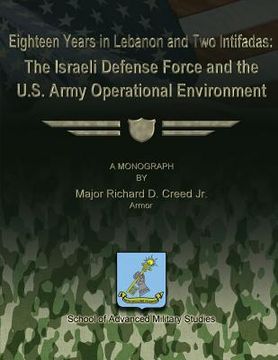Compartir
Eighteen Years in Lebanon and Two Intifadas - The Israeli Defense Force and the U.S. Army Operational Environment (en Inglés)
Richard D. Creed Jr
(Autor)
·
Createspace Independent Publishing Platform
· Tapa Blanda
Eighteen Years in Lebanon and Two Intifadas - The Israeli Defense Force and the U.S. Army Operational Environment (en Inglés) - Creed Jr, Richard D.
$ 25.120
$ 50.230
Ahorras: $ 25.110
Elige la lista en la que quieres agregar tu producto o crea una nueva lista
✓ Producto agregado correctamente a la lista de deseos.
Ir a Mis Listas
Origen: Estados Unidos
(Costos de importación incluídos en el precio)
Se enviará desde nuestra bodega entre el
Viernes 12 de Julio y el
Viernes 19 de Julio.
Lo recibirás en cualquier lugar de Chile entre 1 y 3 días hábiles luego del envío.
Reseña del libro "Eighteen Years in Lebanon and Two Intifadas - The Israeli Defense Force and the U.S. Army Operational Environment (en Inglés)"
This monograph determined that the tactical and strategic experience of the Israeli Defense Force (IDF) since 1981 was relevant to the future operational environment of the U.S. Army. The IDF's experiences are relevant because the Israeli Army was similarly equipped and organized to the heavy units in the U.S. Army, both then and now. Israel faced a similar full spectrum threat, and the IDF had to adapt to enemies who switched to asymmetric methods in order to overcome Israel's conventional military superiority. The IDF of 1981 paralleled the U.S. Army of the 2000 in many ways. It was a mechanized heavy force designed to conduct operations against a Soviet armed and equipped enemy. It fought and defeated some of those enemies decisively eight years previously. Beginning with the invasion of Lebanon (Operation "Peace for Galilee"), the IDF discovered that there were no peer competitors willing to fight it on its own terms. The nature of war changed for the IDF in sometimes unexpected ways, and it struggled to adapt to its changing operational environment. The IDF operational environment became much more complicated, because while it retained the old threats in the form of its Arab neighbors, it added sustained guerrilla war and civil insurrection. This paper summarized the trends and characteristics of the U.S. Army's Contemporary Operational Environment (COE) and used them as the basis of comparison with the IDF operational environment. IDF operations in Lebanon and the two Palestinian Intifadas represented the trends of the IDF operational environment. All of the COE characteristics were present in the IDF operational environment in some form. Nine of the fourteen COE characteristics were present in the IDF operational environment to a significant degree. The comparison between the two operational environments was valid. Having determined that the two operational environments were similar, the remainder of the paper analyzed how the well the IDF adapted to its operational environment. The goal was to determine whether there were lessons relevant to the U.S. Army as it undergoes Transformation. The IDF was at least partially successful adapting to seven characteristics: asymmetry, constrained resources, force protection, information operations, rapidity, homeland sanctuary, and complex and urban terrain. IDF adaptation to those seven characteristics had implications from which it was possible to make recommendations about the course of Transformation. This paper recommended that the U.S. Army pay particularly close attention to the way that the IDF adapted its mechanized and armored units to survive in complex and urban terrain. The IDF's operational environment in Lebanon was so hostile that information superiority had negligible impact on force protection. Since everyone was potentially a threat, successful enemy attacks were inevitable over time. Vehicle survivability provided force protection, which in turn gave Israel's political leadership policy options. The IDF experience confirmed that homeland sanctuary is no longer possible, and that the effort must be joint and multi-agency. The ability to adapt to the rapidity of the operational environment demanded real time intelligence. More importantly, it required both the will and the authority at the proper levels to act on that intelligence while it was still of value. The U.S. Army needs to incorporate asymmetry into its gunnery and tactical training. It also needs to ensure that the opposing forces at the training centers be used to determine likely asymmetric methods of attack against friendly forces and use them so that friendly units can determine countermeasures. None of the findings of this 4 monograph were revolutionary or breathtaking. There were no IDF adaptations that the U.S. Army could not improve upon, as long as it has the will to do so.
- 0% (0)
- 0% (0)
- 0% (0)
- 0% (0)
- 0% (0)
Todos los libros de nuestro catálogo son Originales.
El libro está escrito en Inglés.
La encuadernación de esta edición es Tapa Blanda.
✓ Producto agregado correctamente al carro, Ir a Pagar.

